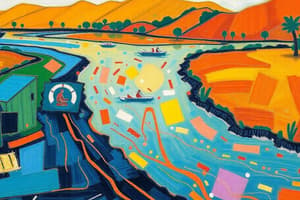Podcast
Questions and Answers
Representations on seals and terracotta sculpture indicate that the ______ was known
Representations on seals and terracotta sculpture indicate that the ______ was known
bull
Terracotta models of the ______ have been found at sites in Cholistan and at Banawali (Haryana)
Terracotta models of the ______ have been found at sites in Cholistan and at Banawali (Haryana)
plough
The field at Kalibangan (Rajasthan) had two sets of furrows at right angles to each other, suggesting that two different ______ were grown together
The field at Kalibangan (Rajasthan) had two sets of furrows at right angles to each other, suggesting that two different ______ were grown together
crops
Most Harappan sites are located in semi-arid lands, where ______ was probably required for agriculture
Most Harappan sites are located in semi-arid lands, where ______ was probably required for agriculture
Did the Harappans use stone blades set in wooden handles or did they use ______ tools for harvesting?
Did the Harappans use stone blades set in wooden handles or did they use ______ tools for harvesting?
What evidence suggests that oxen were used for ploughing in the Harappan civilization?
What evidence suggests that oxen were used for ploughing in the Harappan civilization?
What was the significance of the field at Kalibangan (Rajasthan) in terms of agriculture?
What was the significance of the field at Kalibangan (Rajasthan) in terms of agriculture?
Why was irrigation likely required for agriculture in most Harappan sites?
Why was irrigation likely required for agriculture in most Harappan sites?
What type of tools were archaeologists trying to identify in relation to harvesting practices of the Harappans?
What type of tools were archaeologists trying to identify in relation to harvesting practices of the Harappans?
How did Harappans harvest their crops, according to archaeological evidence?
How did Harappans harvest their crops, according to archaeological evidence?




